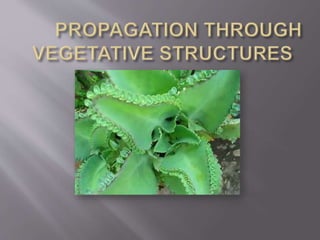Propagation by vegetative structures
•Transferir como PPTX, PDF•
13 gostaram•10,263 visualizações
To know various vegetative structures
Denunciar
Compartilhar
Denunciar
Compartilhar

Recomendados
Mais conteúdo relacionado
Mais procurados
Mais procurados (20)
Fruit set, growth & developmental stages of various fruits

Fruit set, growth & developmental stages of various fruits
Semelhante a Propagation by vegetative structures
Semelhante a Propagation by vegetative structures (20)
asexualreproduction-240204040209-8abe19b0d.pptx.pptx

asexualreproduction-240204040209-8abe19b0d.pptx.pptx
Último
Mehran University Newsletter is a Quarterly Publication from Public Relations OfficeMehran University Newsletter Vol-X, Issue-I, 2024

Mehran University Newsletter Vol-X, Issue-I, 2024Mehran University of Engineering & Technology, Jamshoro
Último (20)
Food safety_Challenges food safety laboratories_.pdf

Food safety_Challenges food safety laboratories_.pdf
Unit-V; Pricing (Pharma Marketing Management).pptx

Unit-V; Pricing (Pharma Marketing Management).pptx
Jual Obat Aborsi Hongkong ( Asli No.1 ) 085657271886 Obat Penggugur Kandungan...

Jual Obat Aborsi Hongkong ( Asli No.1 ) 085657271886 Obat Penggugur Kandungan...
Unit-IV; Professional Sales Representative (PSR).pptx

Unit-IV; Professional Sales Representative (PSR).pptx
This PowerPoint helps students to consider the concept of infinity.

This PowerPoint helps students to consider the concept of infinity.
Asian American Pacific Islander Month DDSD 2024.pptx

Asian American Pacific Islander Month DDSD 2024.pptx
Seal of Good Local Governance (SGLG) 2024Final.pptx

Seal of Good Local Governance (SGLG) 2024Final.pptx
ICT Role in 21st Century Education & its Challenges.pptx

ICT Role in 21st Century Education & its Challenges.pptx
Propagation by vegetative structures
- 2. Vegetative propagation is a form of asexual reproduction of a plant. The new plant is genetically identical to the parent. Vegetative propagation is the process of multiplication in which a portion of fragment of the plant body functions as propagates and develops into a new individual.
- 3. 1. Propagation by roots 2. Propagation by stem 3. Propagation by leaves These structures are called as vegetative propagates or propagules.
- 4. 1.PROPAGATION BY ROOTS:- The roots of some plants develop adventitious buds on them e.g., Dalbergia sissoo (Shisham), Guava, poplars, Albizzia lebbek, Murraya, etc. Some tuberous adventitious roots besides possessing adventitious buds also contain sufficient quantities of, food, e.g., Dahlia and Sweet potato
- 8. TUNICATED BULB NON-TUNICATED BULB 1. Form concentric rings around growth point. 2. Have protected tunic layer of dried ring layers. 3. Not easily damaged during digging. 1.Do not form concentric rings around growth point. 2.Not protected by tunic layer of dried ring layers. 3. Damaged during digging.
- 9. ONION BULB GARLIC BULB DAFFODIL BULB TULIP BULB
- 10. Along with bulb, small underground bulbs are produced which are known as bulblets. The bulblets when grow to full size are termed as offset.Examples- Agave,Aloe,Sansevieria,Sedum etc.
- 11. AGAVE LILY
- 13. POTATO TUBER JERUSALEM ARTICHOKE TUBER DIOSCOREA TUBER IRISH POTATO TUBER
- 15. BANANA RHIZOME BLUEBERRY RHIZOME IRIS RHIZOME
- 17. SLIPS
- 18. Pineapple sucker
- 19. 3.PROPAGATION BY LEAVES:- Some plants produce adventitious buds on their leaves. These buds usually remain dormant, when the leaf is attached with plant. However, the leaves when in contact with moist soil develop new plantlets along the margin.Examples- Bryophyllum,Begonia,Kalanche etc.
- 21. The offsprings are genetically identical and therefore advantageous traits can be preserved. Only one parent is required which eliminates the need for special mechanisms such as pollination, etc. It is faster. Many plants are able to tide over unfavourable conditions. This is because of the presence of organs of asexual reproduction like the tubers, corm, bulbs, etc. Vegetative propagation is especially beneficial to the agriculturists and horticulturists. They can raise crops like bananas, sugarcane, potato, etc that do not produce viable seeds. The seedless varieties of fruits are also a result of vegetative propagation.